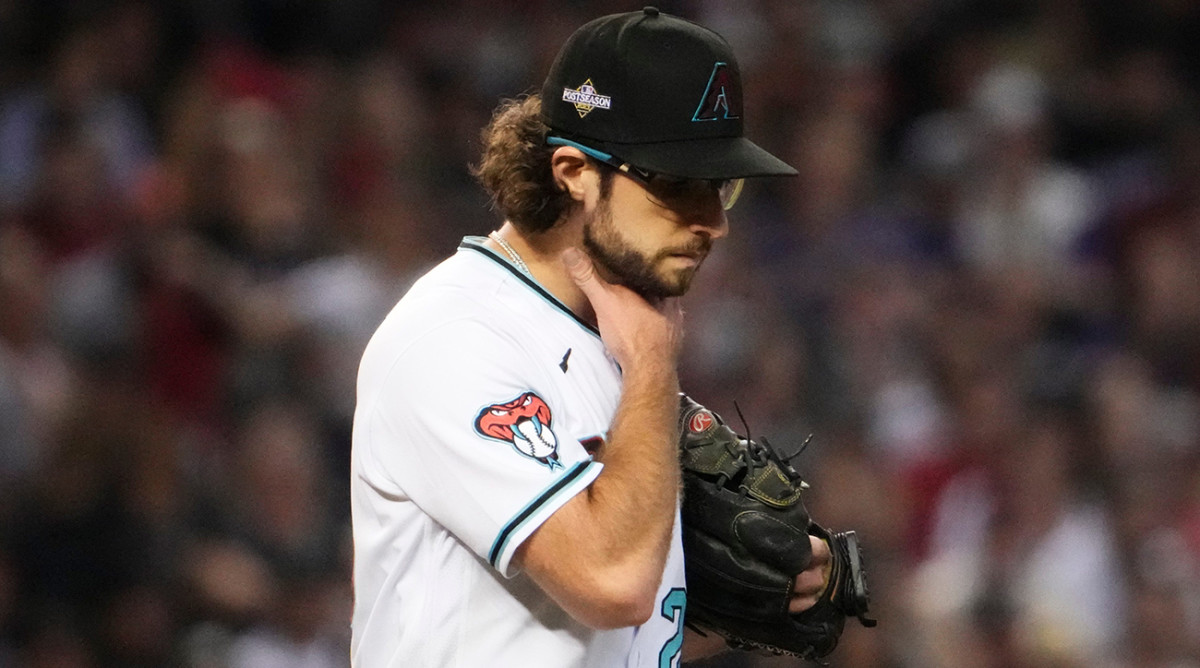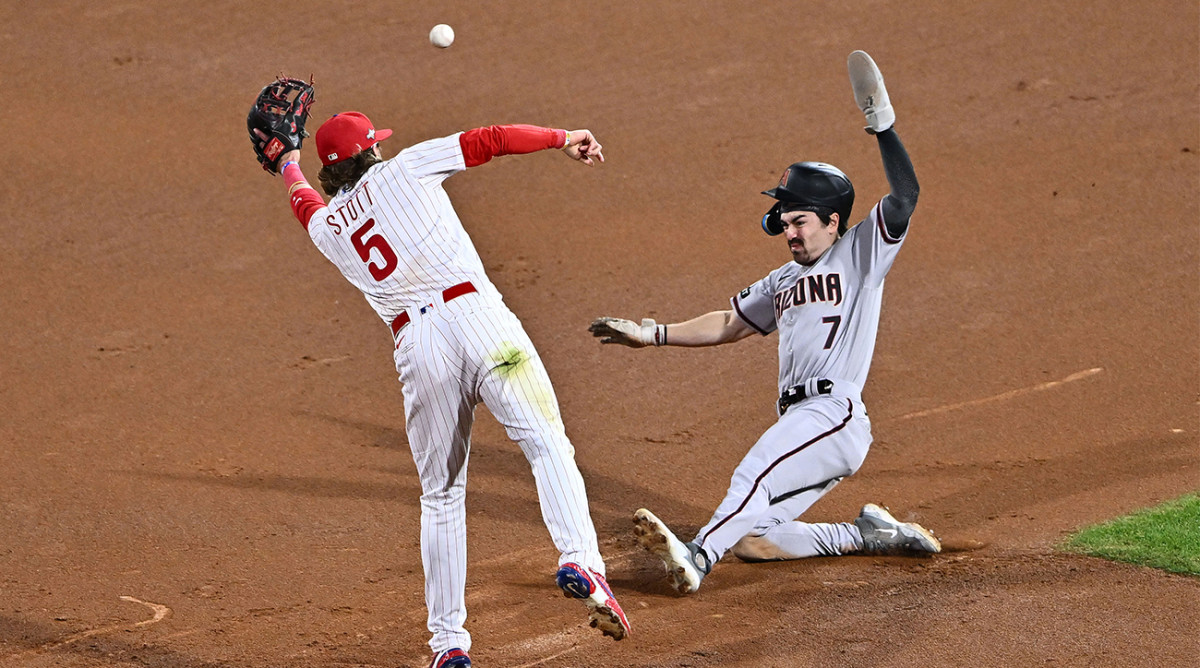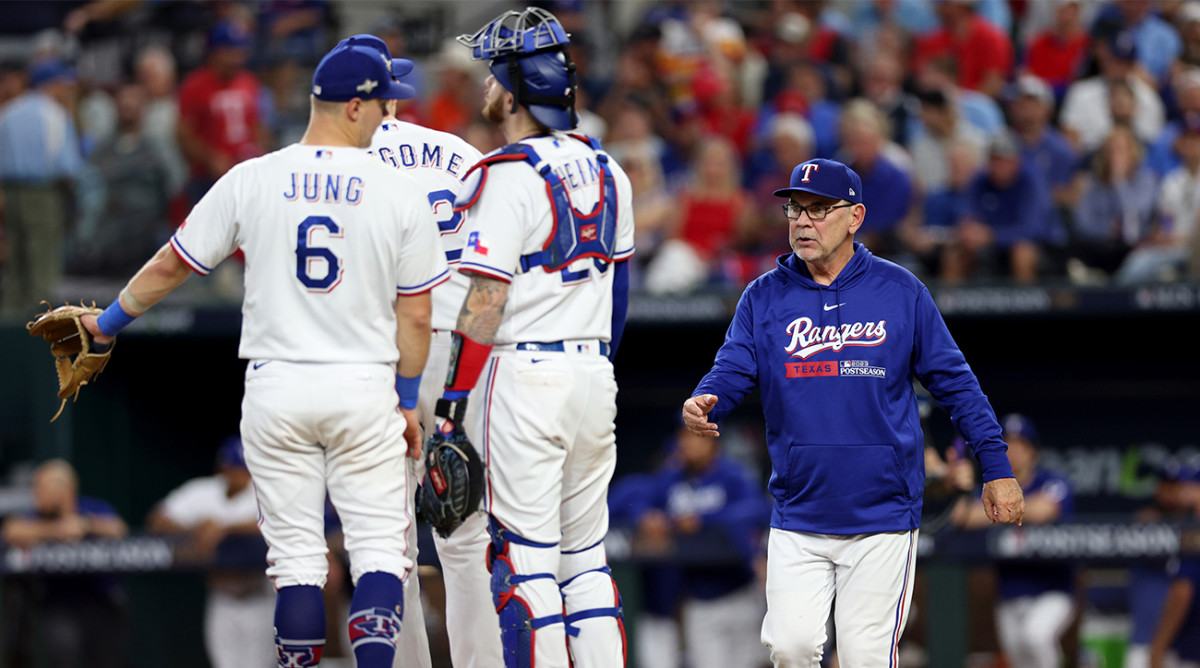Seven Things That Will Decide the Diamondbacks-Rangers World Series

Welcome to the 119th World Series, the first played entirely in climate-controlled settings, the first with two teams that lost more than 100 games just two years earlier, the first with a combined regular-season winning percentage as low as .537 and the first absolutely nobody saw coming.
Well, I did try to warn you before the season started, at least as far as Texas and Arizona looking like surprise playoff teams. But the World Series? Please. But think of their appearance here as a feature, not a bug, of the playoff system.
The Rangers and D-Backs earned their way here by taking out a combined six higher seeded teams, going undefeated when they score first (7–0 and 6–0, respectively), going a combined 14–2 on the road, winning two LCS elimination games each on the road and leaning hard into leadership experience. Bruce Bochy, 68, of Texas and Torey Lovullo, 58, of Arizona have 33 years of combined managerial experience, and pitching coaches Mike Maddux, 62, and Brent Strom, 75, have been at their jobs for 53 combined years.
THE SNAKES ARE ALIVE AND WELL.
— Arizona Diamondbacks (@Dbacks) October 25, 2023
We'll see you in Texas! pic.twitter.com/Ag2TChWMzF
Now that Arizona has fixed its bullpen in the last two months—Paul Sewald, Ryan Thompson and Andrew Saalfrank were not even on the team’s roster when August began but are now in Lovullo’s circle of trust—the teams appear evenly matched. Neither team looks dominant enough to win in four or five games, so we are likely looking at a long series.
How about this delicious possibility: a third Game 7 this year, something that has never happened since the LCS expanded to best-of-seven in 1985. Sign me up for another first. And why not have this be the Year of Sevens? Add up the digits in 2023.
While you consider that math puzzle, here is your field guide to this World Series: the seven (of course) most important questions that will decide who wins:
1. Can Arizona pitchers expand the strike zone on Texas hitters?
After the D-Backs lost the first two games of the NLCS to Philadelphia by a combined score of 15–3, Strom tore up the game plan and went back to work. Or as the most relevant and tech-savvy 75-year-old pitching coach said, “We had to do a complete reboot after two games.”
Strom noticed how Phillies’ hitters were comfortable looking for pitches middle to outside over the plate. Zoned in on that area, they hammered them.
Strom’s reboot: pound fastballs in and up on Phillies’ hitters, then expand the zone with pitches that looked like strikes but wound up outside the zone, especially breaking pitches.
The plan worked perfectly. From Games 3 through 7, Philadelphia chased pitches outside of the zone 36% of the time, the worst five-game stretch of its season.
“The one thing that concerns me,” Strom said, “is if these guys don’t chase as much as Philadelphia.”
Texas is chasing this postseason at a 28.6% rate, the major league average. Overall, chase rate is higher in the postseason (29.7%) than in the regular season.
Against Houston in the ALCS, the Rangers had to solve a barrage of elevated fastballs from Justin Verlander, Cristian Javier and José Urquidy. The task against Arizona is tougher because Strom and run prevention specialist Dan Haren believe in baffling pitch sequences from pitchers who command four or five pitches. They stay out of patterns.
Says Texas hitting coach Donnie Ecker, “I feel like Vic Fangio or some defensive coordinator preparing for an offense with a lot of motion. That’s the way I put it: a lot of motion.”

2. Can Zac Gallen find his groove?
“I’m a feel pitcher,” Gallen says. “When my body is in sync and works efficiently, that’s when I execute best. It’s feel more than anything.”
Gallen is the best pitcher in the series (Nathan Eovaldi is on the best run) and one of the best and most prepared pitchers in the game. He has thrown 232.1 innings this year, almost 50 innings past his career high. In his past 11 starts as he blew past his previous threshold, Gallen is 5–6 with a 5.04 ERA. The good news? His fastball velocity in the postseason is the highest of any month this year (94.3 mph). His tank still has enough gas.
The problem has been his curveball. He has lost velocity, break and command on the pitch. Batters are hitting .350 in the postseason off the Gallen curve, down from .194 in the regular season. Slugging is .550, up from .312.
“I think I’ve worked so hard at finishing that pitch that I’m overcooking it,” Gallen says. “The best curveballs are when you just let it go and don’t try to do too much with it.”
The biggest key for Gallen in Game 1 will be showing he can command that curveball early. If you see chase swings in the first inning on his curveball, look out; he’s in a very good spot. That’s because ...
3. Can the Rangers keep ambushing pitchers?
Texas has five of the top 49 hitters in MLB when it comes to first-pitch swing rate: Corey Seager, Josh Jung, Leody Taveras, Marcus Semien and Adolis García. In the postseason, Texas is hitting .400 on first pitches on 26 hits in 65 at bats. Both are the most in baseball.
One more for good measure. #GoAndTakeIt pic.twitter.com/dcUJXGZSn7
— Texas Rangers (@Rangers) October 24, 2023
Arizona’s pitching philosophy is built on three tenets:
- Win the battle of three: After three pitches, the batter should be retired, or the pitcher should be ahead in the count.
- Limit hard-hit balls.
- Get chase swings.
What that generally means is Arizona likes to attack the zone early so it can expand the zone to get outs on chase swings. But Texas does not concede first-pitch strikes. The Rangers hack at most anything that’s in the zone and not on the edges on 0–0 counts.
The downside? Texas made more one-pitch outs this season than any team—and by a lot (495; Baltimore was second at 432). The upside? Texas is slugging .692 this postseason on first pitches, up from .642 in the regular season (fifth best). It does so much damage early in the count it doesn’t mind the one-pitch outs.
“Semien and Seager could make outs on the first pitch,” Strom says, “and García still might be swinging first pitch. Nobody else would dare risk a three-pitch inning. Doesn’t matter to them.”
Merrill Kelly, Arizona’s Game 2 starter, is best equipped to turn Texas’s aggressiveness against it because he mixes his pitches and works the edges at 0–0. Gallen in Game 1 must change his habits of pounding the zone with fastballs.
Gallen throws a ton of first-pitch strikes (65%), and most of those are fastballs (58%, third-most among qualified starters). Batters hit a career high .406 against his 0–0 pitches this year with a career-high .670 slug.
And keep this stat in mind in the bottom of the first inning of Game 1: On first pitches in the first inning with the bases empty, Gallen throws a fastball 85% of the time. Hitters drool over finding those usage anomalies.
Here’s one sure thing: Gallen will not throw a first-pitch fastball to Semien leading off the first inning. Why? When Gallen threw a first-pitch fastball to Kyle Schwarber in ALCS Game 1—right down the middle and a tick below his average velocity—Schwarber ripped it for a home run. It was the 89th time in his past 90 starts that Gallen opened the game with a fastball. Think Schwarber knew what was coming?
So how did Gallen start ALCS Game 5 to Schwarber? Cutter for a ball.
4. Can the D-Backs create runs with stolen bases?
It is fitting that Arizona is in the World Series in the year major rules changes were designed to make the game faster and more athletic. Teams such as the Diamondbacks are proving a diversity of styles is good for the game, rather than 30 teams adopting the same three true outcomes static brand of baseball.
The D-Backs took out Philadelphia because they completely out-executed the Phillies in offensive baseball. It’s not just stealing bases. It’s sacrifice flies. It’s bunting runners up. (Yes, bunting; Lovullo, playing for a tie on the road, ordered a bunt in the fifth inning with his team trailing. It was only the fourth postseason sac bunt that early on the road when trailing in the past 12 years! Why so few? Analytics decided it was a bad play. The darn bunt helped Arizona win.)

Postseason baseball is competed at 90-foot increments, and Arizona kept seizing real estate while Philadelphia did not. The biggest at bat of Game 7 came when Trea Turner followed a leadoff double in the fifth by Schwarber with the Phillies trailing 3–2. The crowd had come back to life. The Phillies could have tied the game without a hit (move him over, get him in). Turner, smartly, tried to push a bunt to the right side to move Schwarber to third. But his bat angle was poor, and he tapped it foul. Apparently lacking confidence—he should have remained in bunt mode—Turner swung away at the next pitch, a curveball from Joe Mantiply designed to get a rollover. Turner rolled over to third, a huge empty at bat. Bryce Harper and Alec Bohm each got under pitches for easy outs in the air. Ballgame.
“From spring training we’ve made it our identity to move the baseball and get every 90 feet we can get,” Lovullo said. “By now it’s who we are. And I’d like to think as much as that style can get you to the postseason, even more so it can get you through the postseason.”
Said Texas catching instructor Bobby Wilson, “They’re going to run. We know that. It still comes down to pitch execution more than anything. Usually does.”
5. Will the three middle games be slugfests?
The Rangers have a rusty Max Scherzer lined up for Game 3 and Andrew Heaney or Dane Dunning for Game 4. Arizona has Brandon Pfaadt in Game 3—he’s averaging 4 1/3 innings in his past nine starts—and a bullpen game for Game 4. Then you get to Game 5, the only game in this series in which teams play for a third straight day, when bullpens are gassed.
Neither team has formidable depth in the rotation or bullpen. There is much pressure on the managers to navigate those three games while using their whole staff.
6. Will Corbin Carroll become a national superstar?
He fills up a stat sheet as if it were a bingo card. NLCS Game 7 was the CliffsNotes version of what this dynamic player can do: the first player in the history of winner-take-all postseason games with three hits, two RBIs, two runs and two stolen bases—and he also added a two-strike sac fly and caught the final out.
Carroll is one of the two or three best base runners (not just the fastest), has tremendous power to all fields and can take over a game the way Rickey Henderson did: by slugging, running and disrupting pitchers.
7. Will the managers decide this series?
Even as analytics-driven front offices seized power from managers, the manager still factors heavily in the postseason, even more so now as the pitch timer moves the game along faster. There are more pitching decisions and less time to prepare for them and make them.

Pitching decisions dominate the second guessing. Nobody has thrown a complete game win in the postseason in six years! The last time a starter covered nine innings was Justin Verlander in 2017 ALCS Game 2 for Houston against the Yankees. Since then, there have been 504 consecutive postseason starts without the starting pitcher shaking his catcher’s hand after getting the last out. There is an 88% chance the starter is not even going seven innings. Check out these numbers since Verlander’s CG:
Postseason Starts Since 2017 ALCS Game 2
Total | 504 | |
|---|---|---|
7 innings or more | 58 | 11.5% |
5 innings or less | 308 | 61.1% |
The vast majority of postseason starts in this era cover only five innings or fewer. That’s where managers come in. And it’s hard to go against Bochy in this environment. How good is Bochy at running these games? Some telling stats:
- His teams have won 14 of his past 15 series (losing only to Joe Maddon’s Cubs in the 2016 NLDS).
- Game 1 marks his 90th postseason game. He is 53–36 (.596), trailing only Joe McCarthy (.698) and Sparky Anderson (.618) for the best postseason winning percentage among those who managed at least 40 games.
- If it’s a bullpen game, he’s probably going to win it. His relievers are 19–9 in postseason games.
- If it’s a close game, he’s probably going to win it. He is 20–8 in games decided by one run.
